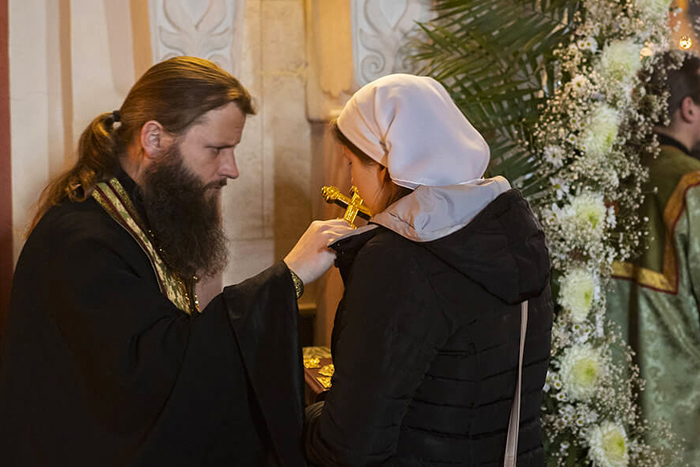
The Synaxis of all Russian saints who lived on Mount Athos is celebrated in the Russian St. Panteleimon Monastery on Mt. Athos on May 7/20. That day was dedicated to the memory of all Russian Athonites by the Synod of Elders of St. Panteleimon Monastery with the blessing of Schema-Archimandrite Jeremiah (Alekhin), the abbot of this monastery, because it is the day on which the old Russian tradition celebrates the blissful repose of St. Anthony of Kiev who is known as “the pioneer of Russian monasticism”. Aside from that, it is on the same day that the Church commemorates other holy Russians who lived on Mount Athos: St. Nil Sorsky and St. Pachomius the Russian. It is also the day of St. Nil the Myrrh-Gusher of Mt. Athos.
The Synaxis of all holy Russian Athonites counts more than sixty Athonite ascetics, canonized by various Orthodox Churches at various times. Some of them were Serbs, Greeks, or Georgians but their lives were somehow linked to the Holy Russia or to the Russian monks on Mt. Athos.
There was a significant decline in the number of monks on Mount Athos from 1910 to 1971. Their numbers dwindled from 9,900 to 1,145. Their median age was 55. Outside observers predicted the imminent end of Athos as a monastic republic. Projects were drawn up to turn the Holy Mountain into a huge museum and tourist site. Elders and ascetics did not have younger disciples, which endangered the millenium-long tradition that had been passed on from generation to generation. Enormous monasteries and sketes, which had been teeming with life, were deserted and desolate.
Even the most optimistic observers didn’t expect the revival of the Holy Mountain. However, the Most Holy Theotokos didn’t let her earthly lot be abandoned. The number of monks has been growing at a steady pace since 1971, and has reached 1,800 by now. It was made possible largely by establishing closer ties between coenobitic and hesychast traditions that have breathed new life into Orthodox monasticism.

People of various professions and ages have come to the Holy Mountain. The majority of them are young men with university education under their belts. Among the newcomers, there have been famous scholars with international fame. It must be stressed that they came to Athos not because they wanted to transform and modernize it but because they wanted to be part of its tradition.
Not all monasteries were re-populated evenly, though. Initially, the number of monks increased in Iviron, Helandariou, Filotheou, Simonos Petras, Agiou Pavlou, Osiou Grigoriou, and Esphigmenou. The monks came in groups, not one by one. They came into monasteries from sketes and cells, which account for three fifths of all Athonite population. Since mid-1970s, many monks (or rather, groups of monks, like previously) moved again: this time from more flourishing monasteries to desolate ones.
The early 1980s saw a return of monks from monasteries back to sketes and cells. Having spent many years in large monasteries and having received proper monastic training, many monks moved to sketes and cells. It was around that time that coenobitic way of life finally replaced the idiorhythmic (solitary) one. A constellation of charismatic elders played the key part in the revival of Athonite monastic life by attracting a lot of people to monasticism and influencing the younger generation of monks to a great extent. Among them, there was Elder Joseph the Hesychast (†1958) – a hermit who was the spiritual father of six out of twenty monasteries on Mt. Athos; Elder Paisius the Athonite (Eznepidis, †1994) who restored several monasteries and was the spiritual father of many monks and lay people; Father Sophrony (Sakharov, †1993) who founded St. John the Forerunner Monastery in Essex, England, and wrote multiple books including the classic biography of St. Silouan). He spent more than 20 years on Athos (1925–1947); he was the spiritual father of several monasteries and quite a few cells. Other contemporary elders, such as Arsenius the Hesychast (†1983), Porphyrios the Kapsokalyvite (†1991), Ephrem of Katunaki (†1998), and Theoclites Dionysiatis (†2006), also deserve special mention. There are tens and even hundreds of elders on Athos even now. The living chain of tradition remains unbroken even today.
Translated by The Catalog of Good Deeds



